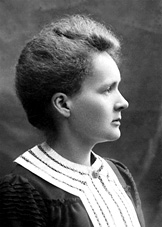Madam Marie Curie
 One
of the most challenging roles a woman must play her in her life is that of being
a mother. So when a woman like Marie Curie raises her children
in addition to contributing some of the most revolutionary research to modern
science, one has to sit back and really appreciate the dedication to both her
family and her work for achieving these goals.
One
of the most challenging roles a woman must play her in her life is that of being
a mother. So when a woman like Marie Curie raises her children
in addition to contributing some of the most revolutionary research to modern
science, one has to sit back and really appreciate the dedication to both her
family and her work for achieving these goals.
Born in Warsaw in 1867, Marie Sklodowska grew up in a household that viewed education as a very important aspect of their children's development. The youngest of five children, Marie's early life would be tumultuous, with the death of her sister Zofia and later her mother. During these years, she developed a very strong study ethic, which showed as she graduated from the top of her class at the age of 16.
Due to the discriminating russian laws of her time, Marie was not allowed to attend the all male universities, and was forced to go to work. She would donate a portion of her salary to her sister Bronisława's education at the university of Paris. A few years later on 1891 she finally had the opportunity to join her sister at the university and further her own education.
In Paris, Marie would begin her in-depth studied in areas like physics and chemistry. She would obtain and undergraduate degree in physics in 1893 and a master's in mathematics a year later. She would eventually go on to receive a doctorate from the university, the first woman in France to ever do so.
It was during her years at the University of Paris where Marie met Pierre Curie, Professor in the School of Physics. The two hit it off, no doubt because of their related field of study, and were married in 1895. The two would spend the next few years researching together, and with the discovery of radioactivity in 1896 by fellow scientist Henri Bequerel, the two would go on to discover and isolate two new elements: Polonium (named after Marie's homeland of Poland, and Radium.
During these times, Marie and Pierre often worked in very difficult laboratory conditions, and because of the radioactive elements they were dealing with, this would effect their health in years to come. Because radiation was a new discovery, no one really knew the impact it would have on the body at the time.
 It
was these two important discoveries which resulted the couple, along with Becquerel,
receiving the Nobel Prize in Physics in 1903 for their contributions
to the study of radiation. Marie was the first woman to ever receive the prize,
and would make history again in 1911 for receiving another Nobel prize for her
continued study of radium, the only person in history to win a Nobel
Prize in two different fields of scientific study. Part of Marie's
contribution concluded developing methods for separating radium from radioactive
residues to study its therapeutic properties, which she would endorse later
on on the war.
It
was these two important discoveries which resulted the couple, along with Becquerel,
receiving the Nobel Prize in Physics in 1903 for their contributions
to the study of radiation. Marie was the first woman to ever receive the prize,
and would make history again in 1911 for receiving another Nobel prize for her
continued study of radium, the only person in history to win a Nobel
Prize in two different fields of scientific study. Part of Marie's
contribution concluded developing methods for separating radium from radioactive
residues to study its therapeutic properties, which she would endorse later
on on the war.
At this time Marie also become a member of the Conseil du Ohysique Solvay and a member of the Intellectual Co-operation of the League of Nation. She would go on to be one of the most admired scientists around, earning honorary science, medicine, and law degrees from universities from all over the world.
Her accomplishments would not be had without tragedy; in 1906, Pierre was struck by a horse and carriage while crossing the street, and was killed by the accident. Speculation around whether Pierre was weakened by his exposure to radioactive elements over the years is often brought up when discussing his death. After her husband's tragic death, she would take his place as the Professor of General Physics in the Faculty of sciences, the first women to ever hold this position.
Around the same time, scandal arose regarding a possible affair between Marie and a physicist named Paul Langevin, which Marie's opposition in the scientific community used to exploit her in the hopes of tarnishing her name. While she was well known in France for her work, she wouldn't exactly be loved by all.
Marie continued on without her husband, winning awards and continuing her research and contribution to the scientific community. After World War I broke out in 1914, Marie, along with the assistance of her daughter Irene, introduced the use of mobile radiography units to treat the wounded (which would famously become known as "Little Curies"). Marie would personally devote herself to this work, donate the tubes of radium she purified, which gave off a radioactive gas that later became known as radon.
Throughout the 1920's, Marie toured the United States to raise funds for further research. After her second visit she received enough funds to start the Warsaw Radium Institute, notably a $50,000 gift donated by President Herbert Hoover. In addition to this Institute, headed by her sister, she would go on to head the Pasteur Institute and a lab at the University of Paris. Her death in 1934 has been attributed to the radiation she surrounded herself with for many years.
For her great work and contributions to science, Marie sacrificed herself, albeit unknowingly. Her legacy would live on through her children, who had a similar drive and interest in science. Their first daughter, Irene, would do mom proud by winning her own Nobel Prize in 1935. While Marie Curie made things happen for herself, she also made sure her children had the same opportunities, a trait that can only be attributed to being a great mother.









